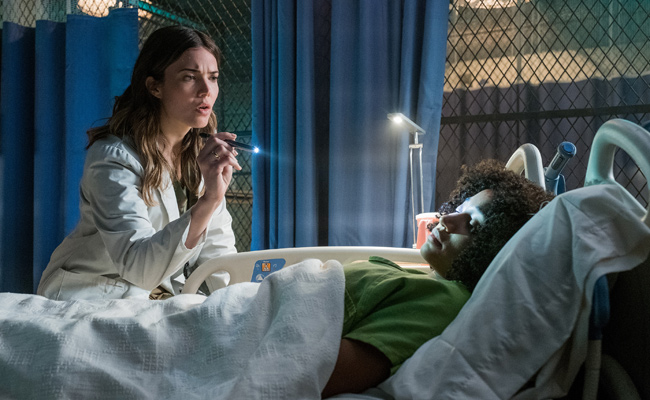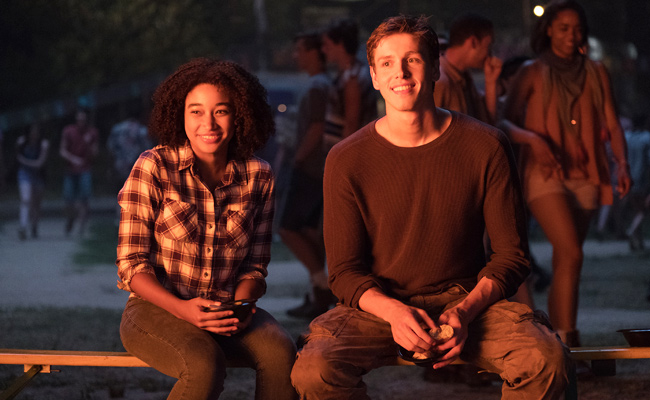
It’s tempting to mock every new entrant into the post-apocalyptic tween romance canon, of which The Darkest Minds is firmly a part. It’s set in a world where a virus has killed off most of the Earth’s kids, but the ones that did survive have special powers. They’ve been corralled into camps by the adults, but wouldn’t you know it, our teen protagonist has an even specialer power that could be the key to it all. It’s like X-Men meets Hunger Games meets Divergent meets…
Like I said, it’s tempting to mock every narrative where the teen protagonist just so happens to be the specialist most important person in the universe, but that’s basically true of virtually every story aimed at teens since the dawn of time. Believing you’re the center of the universe, that you’re the first person ever to think certain thoughts, is the nature of being a teen. And on balance, holding the key to defeating a repressive society is probably a more interesting reason for being special than other versions, like say, being a secret princess or whatever (why doesn’t Disney get more grief for their weirdly Victorian obsession with inherited power?).
Anyway, that’s The Darkest Minds, a grandiose premise for grandiose teens, from the angsty title on down (losin’ my sight! losin’ my mind! Wishin somebody would tell me I’m fine!). Based on Alexandra Bracken’s 2012 YA novel series of the same name, TDM follows Ruby (played by the beautiful polyracial Amandla Stenberg), a 16-year-old who, like the rest of her peers, lives in a giant work camp segregated by color. The colors are based on special powers, see. The greens are the less dangerous teens, basically superpowered nerds. Yellows can bend— er, let’s say manipulate — electricity. Blues are telekinetic, reds are basically fire-breathing dragons, and wouldn’t you know it, our protagonist is the most special color of them all: orange, the Jedi mind tricking brain controllers. Oranges and reds are so dangerous that they’re marked for summary execution. Ruby manages to Jedi mind trick her intake doctor (let’s call him “Sorting Hat“) into marking her Green to stay alive. But that means she has to keep her gifts hidden to protect herself — that’s probably why her mind’s so dark!

One of the best things I can say about The Darkest Minds, a Movie Definitely Not Aimed At Me™, is that it’s not boring. Sure, it’s melodramatic, as you would expect, the teens’ attempts at flirting are wooden and awkward, as you would expect, and a lot of the exposition is about as elegant as a ball peen hammer. YA books are so exposition heavy that part of the fun of the movie adaptations is simply watching them try to cram it all in. When Ruby is found out, she gets smuggled to safety by a sympathetic doctor, played by Mandy Moore. On the drive through the outside world (specifically, Virginia) they pass a massive graveyard full of rotting school buses (no kids, I can dig it!). Later they pass shuttered storefronts and abandoned factories. “Most people moved to the city to try to get jobs,” Moore’s character says. “No kids, no economy.”
Haha, what? Were the kids working at the factory? Was the factory making YA novels? I’m going to need you to elaborate a little more on this kid-based economic system. There’s another headscratcher when Ruby takes the wheel during a car chase. “This is so not like riding a bike!” she yells, mysteriously.
Turns out, Moore’s character works for something called “The League,” who want to rescue the kids from labor camps and use them for… something. Before we can find out what that is, Ruby bails and joins up with her love interest, Liam (Harris Dickinson, from Trust/Beach Rats, who’s like a less-grating version of Eddie Redmayne) and his multi-racial band of teen outlaws, made up of Chubbs, so called because apparently he used to be fat (Skylan Brooks), a spectacled Green, and pint-sized Suzume (Miya Cech), a mute Yellow. Together they’re trying to reach a promised settlement of outlaw kids, who live free of adult shacklehood.
Probably the best part of The Darkest Minds is when the gang actually gets to this promised land, and it basically looks like Burning Man for tweens — kids slowly swaying to music, mutants using their powers to hoist paper lanterns in the air while they bliss out in the dirt. I love it when even Heaven is basic.
Neither The League nor tween Burning Man heaven turn out to be quite what they seem, and our shifting conception of who’s good and who’s bad in this story are admirably complex for something aimed at teens. In a story like this, though, it’s less about the what and more about the why. What are these mutants meant to represent? What insight into the human condition are we getting from this? Because stylistically it’s a mash-up of 100 other things.
The answer to those questions is… I don’t know. The Darkest Minds basically ends on a to be continued, and it’s hard to say whether it’s creatively bankrupt or just parsimonious. Maybe we’ll find out what it all means in the sequel? Will we care by then? Time will tell. Or who knows, maybe it won’t. As it is, we have a movie in which a Mandy Moore character plays a prominent role in the story, yet gets about five minutes of total screen time, and we’re left to speculate her meaning based on the fact that she seems nice. Should I have read the book first?
Long on set up and leaden dialogue, short on resolution, The Darkest Minds is set in an apocalyptic future where teen movies no longer have endings. Oh, wait that’s the present.






